Why Dry Hot Peppers?
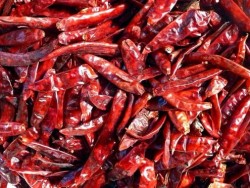 The main reason to learn how to dry hot peppers is simply to enable you to keep them for a long time. Peppers can last for several days to a few weeks at room temperature or in the refrigerator before they start to rot. Freezing peppers, if done right, can make them last several months, but the thawing process can be a tricky one where often you’re left with overly soft and mushy chiles. Dried chiles can last from several months to a few years if stored properly.
The main reason to learn how to dry hot peppers is simply to enable you to keep them for a long time. Peppers can last for several days to a few weeks at room temperature or in the refrigerator before they start to rot. Freezing peppers, if done right, can make them last several months, but the thawing process can be a tricky one where often you’re left with overly soft and mushy chiles. Dried chiles can last from several months to a few years if stored properly.
Removing moisture from peppers will magnify and intensify the heat, flavor, and natural sugars it contains. Dehydrated chiles pack more fiery punch and ferocity in both solid food and hot sauce recipes than fresh peppers. Plus, if you grind or crush dried peppers, you can use it as an all-purpose flavoring and seasoning for any occasion.
Preparing Chile Peppers to Be Dried
Before you start drying peppers please take the following precautions:
If you’re drying peppers indoors, keep the area well-ventilated. Warmed peppers will give off pungent fumes that are irritating to the eyes. If you have a ceiling fan, use it; or better yet, open your windows and bring in a portable fan or two to keep the air circulating and minimize the watery eyes and burned nasal passages. Take extra precautions around young children, pets, or anyone sensitive to spicy foods.
If possible, always wear gloves when handling hot peppers. Be sure to wash your hands thoroughly after touching hot peppers. Do not scratch your eyes, nose, face, or any other sensitive area of your body after handling.
Inspect each pepper before starting the drying process. Discard peppers if they have:
- Soft, mushy, or spoiled areas
- White, grayish, or diseased-looking spots
- Have a questionable or rotten odor
Wash the peppers with warm water and dry thoroughly with a cloth towel.
Remove the stems from your peppers. If you’re drying them in your oven or food dehydrator you may wish to slice the peppers length-wise (this will allow them to dry faster). If you’re drying the peppers indoors you may want to keep them whole as it usually takes a few weeks to dry and not cutting them open helps prevent premature spoilage (but you may wish to experiment based on your regional humidity levels and temperature).
Drying in the Oven
You can dry peppers in any regular kitchen oven. Conveniently, this method of drying can be done in just about any kitchen in the western world, but there is one big disadvantage; it may take several hours to a few days for the peppers to fully dry, depending on the size. It can also heat up your kitchen considerably if you’re drying on warm spring or hot summer days.
Simply position the peppers on a pan or cookie sheet in a single layer and place them in the oven. Set the oven to its lowest temperature setting, which is usually labeled as “WARM”, or just below 150 degrees Fahrenheit (120° to 140° is desirable). To allow moisture to escape, keep the oven door slightly open at least a couple of inches (now you know why it can make your kitchen hot). Every hour, rotate and/or flip the peppers over for even drying.
If you find peppers getting soft, brown/black, or extremely hot on the side where they touch the pan, then they’re getting cooked; you certainly don’t want this, as you’re just trying to dry these to use at a later date. To prevent this, try one of the following:
- Turn down the temperature slightly. Not all ovens are calibrated the same – some may be off by 10° or more from the “real” temperature.
- Flip the peppers over and move them around more often
- Open the oven door wider
As soon as they’re fully dry, remove them from the oven and place them in an air-tight container. Larger, thicker-skinned peppers will take longer to dry than smaller or thin-skinned chiles.
Drying in a Food Dehydrator
This is the quickest and easiest way to dry not just chile peppers, but just about any fruit or vegetable.
If you’re shopping for a food dehydrator online, I recommend the following things:
- Purchase a dehydrator with a motorized fan. Air that’s constantly circulating will dry your peppers faster.
- Don’t be afraid to spend a few extra bucks more to get the best. A cheap dehydrator will have a noisier motor, will take much, much longer to dry your foods, and will be more likely to break sooner. The price of a good dehydrator will start at around $60 US.
- Read online reviews to get a sense of what other people think works best for them.
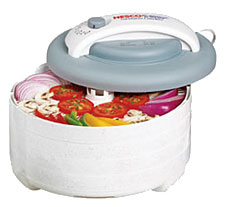 What do I use? A Nesco American Harvest FD-61 Snackmaster Encore Dehydrator. It’s relatively inexpensive, has a powerful yet quiet motor (when it’s turned on in the kitchen, the dehydrator’s fan has the volume level of a microwave oven running), and dries food evenly no matter what rack it’s on. But like I said, do the research and find the right brand and model for you and your needs.
What do I use? A Nesco American Harvest FD-61 Snackmaster Encore Dehydrator. It’s relatively inexpensive, has a powerful yet quiet motor (when it’s turned on in the kitchen, the dehydrator’s fan has the volume level of a microwave oven running), and dries food evenly no matter what rack it’s on. But like I said, do the research and find the right brand and model for you and your needs.
Once you have a dehydrator in your house or place of business and have it set up in a well-ventilated area, it’s time to dry your chiles. If the chiles are medium or large in size put them length-wise and place them on the dehydrator’s tray with plenty of space around each piece for good airflow. Smaller peppers (1 inch or less in length) can be left whole to dry.
If your dehydrator has a temperature setting, place it between 135 and 145 degrees. Let the chiles lay in the dehydrator for 8 to 12 hours, checking every so often to see if the smaller or thinner pieces have dried out. Larger pepper pieces may take a few additional hours to dehydrate.
You’ll notice that you’ll accumulate a lot of loose seeds on the bottom of your dehydrator. Be sure to save these either for replanting purposes or for using later in your dried chile recipes.
After complete, place your veggies in air-tight plastic bags or containers to prevent moisture from getting on them.
Drying Hot Peppers Indoors
This is the “easiest” method of drying peppers, yet probably the most time-consuming. Place whole or sliced chile peppers single-layer in a bowl, plate, or sheet and set them in a very dry, warm, and extremely well-ventilated area with loads of sunlight. Rotate the peppers regularly and discard any that show signs of softness or spoilage. If at all possible, place your bowl or sheet outdoors when the forecast calls for hot, sunny, and dry weather (this will speed up the drying process). Within one or two weeks, you should start seeing your beloved chiles get dry and brittle.
Drying Hot Peppers Outdoors
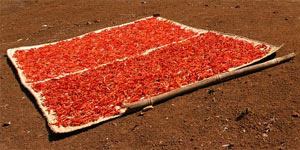 There are a couple of different methods for drying hot peppers outdoors. One, you can dry the aforementioned way of laying them out on a sheet and placing them outside when there’s a long string of hot and sunny days. Sun-drying can be very effective if the weather cooperates and if you’ve picked a spot where you can get maximum exposure to direct sunlight. If you’ve sliced the peppers, you may wish to place a screen over the sheet or bowl to provide protection from insects.
There are a couple of different methods for drying hot peppers outdoors. One, you can dry the aforementioned way of laying them out on a sheet and placing them outside when there’s a long string of hot and sunny days. Sun-drying can be very effective if the weather cooperates and if you’ve picked a spot where you can get maximum exposure to direct sunlight. If you’ve sliced the peppers, you may wish to place a screen over the sheet or bowl to provide protection from insects.
Another good way of drying chile peppers outdoors is to hang them from a string. Grab some whole peppers with the stems still on, take a long, sharp needle, and string them together with a strong thread or fishing line through their stems.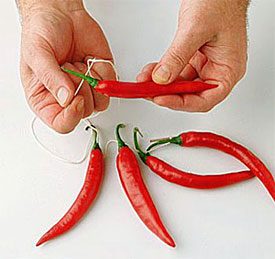 Unlike decorative ristas (which clump several hanging chiles together in a tighter space), you’ll need to leave plenty of room in between peppers for proper airflow. At one end of the string, tie a small stick or wooden dowel to prevent the peppers from sliding off. Hang up your strand of peppers securely in an area where they’ll get plenty of sunlight and fresh air.
Unlike decorative ristas (which clump several hanging chiles together in a tighter space), you’ll need to leave plenty of room in between peppers for proper airflow. At one end of the string, tie a small stick or wooden dowel to prevent the peppers from sliding off. Hang up your strand of peppers securely in an area where they’ll get plenty of sunlight and fresh air.
It can take up to two weeks of drying time in good weather.
When They’re Dry
Properly dried peppers should be devoid of any signs of moisture or soft “fleshiness”. Fully dried peppers can still retain a bit of flexibility in their skin – you don’t have to dry them until they’re brown, crumbling, or hard as a rock. But when in doubt, the pepper should be uniformly dry, slightly brittle, and have tough skin.
What to do with them you’re done? You can:
- Separate them by pepper type and store them in high-quality Ziploc-type plastic bags or plastic containers. This way you’ll always have a handy supply of dried peppers to use in sauces, soups, and other dishes.
- Crush them in a food processor, blender, or spice mill and create a chile pepper seasoning.
- Give them to family and friends as unique gifts so that they can spice up their own recipes.
- Plant the seeds for a new crop of chile pepper plants.

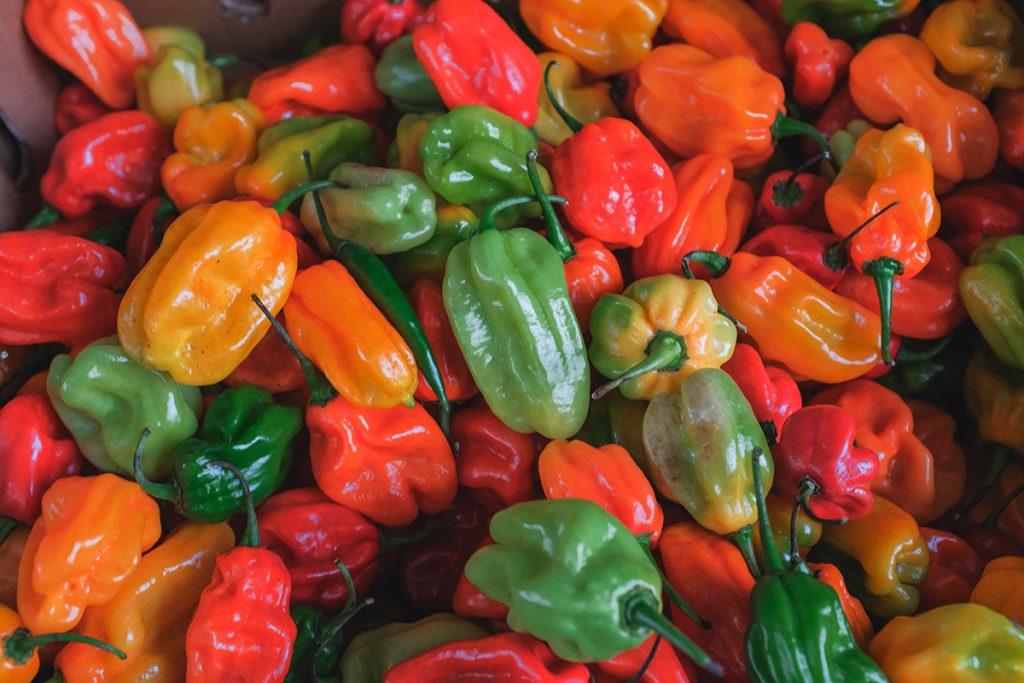
3 Comments
LH
Super helpful! Thanks!
Chunky Nugget
Exactly the article I needed! Thanks
Susan
I dried ancho chiles in the ooven with the door cracked at 170 for 12 hours and they turned gray and soft